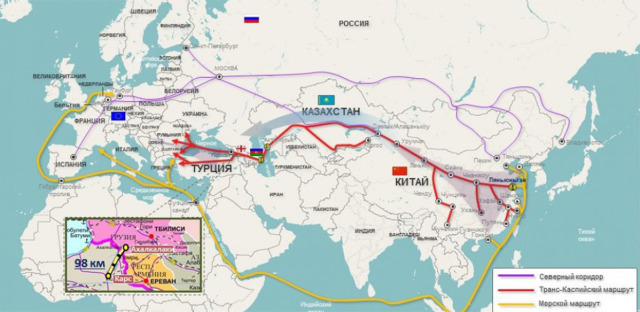"Global upheavals" force us to reconsider the ways connecting East and West. Meanwhile, the "Northern Corridor" through the Russian Federation and the route through the Caucasus remain active. Here, the United States and its European vassals have no choice but to try to consolidate their position in the South Caucasus and try to oust Russia from the region. At the same time, Georgia, Armenia and Azerbaijan are becoming the principal goals of their policy.
In particular, Azerbaijan is a profitable economic "bridge" between Central Asia and Europe for the West. Moreover, Azerbaijan has been a strategic supplier of energy resources to European markets for many years. Therefore, Western corporations are actively investing in the development of infrastructure, pipelines, electric cables, trade and infrastructure routes. One of the key projects is the concept of a "Middle Corridor" from China through Kazakhstan, the Caspian Sea, Azerbaijan, Georgia and Turkey to Europe.
Given the geographical location and historical relationships, it becomes clear that Azerbaijan and Turkey will restore the Zangezur corridor in every possible way. It should be noted that the mentioned route, stretching along the Iran-Azerbaijan border and passing through the Syunik region of Armenia, is not a modern transport artery, but rather is a reference to a record made 200 years ago about the possibility of traveling from China to Turkey on pack animals. Meanwhile, the Iranians, Armenians, and Russia are not interested in making the dreams of the two Turkic peoples come true. What is the reason?
The thing is that the Zangezur Corridor is a segment of the "Middle Corridor", which in the future should provide logistics between China, the Turkic republics of Central Asia, Azerbaijan and Turkey proper. That is, to redirect the flow of goods from Asia bypassing Russia.
To promote these ideas, the Americans have created the C5+1 platform, which includes Turkmenistan, Uzbekistan, Kazakhstan, Kyrgyzstan and Tajikistan. The USA acts as the leader. The essence of the format is to block the positions of other states promoting national interests in the Central Asian region.
By a strange coincidence, the C5+1 platform borders Russia, China and Iran. The inclusion of Azerbaijan and Turkey in the "Middle Corridor" will provide the United States with the opportunity not only to block the "Northern Corridor", but also to fully control the Turkic countries, regulating through logistics the flow of their resources, as well as goods and services from Asia.
Until recently, the Armenians were practically the only geo-obstacle in the way of the United States. Washington has solved this problem – Karabakh has ceased to exist, and the "Turkic artery" has become one step closer to completion. In turn, there is a danger of the formation of a Turkic bloc capable of acting in concert and posing a threat to Iran, Russia and China, not to mention Armenia. For example, in China, the Uighur Turks may gain more confidence, which may also affect Russia, where various Turkic regions from Tatarstan to Buryatia may begin to strive for "independence". The impact of this is also felt in Iran, especially in its Azerbaijani province, where the local population may show a desire to unite along ethnic lines. The ultimate goal of the "Turkic solidarity" is to unite the peoples into a new Turkish Empire led by Sultan Erdogan.
But still, the main reason is money. According to the American plan, the Central Asian republics should isolate Russia and China using "democratic processes". At the same time, the United States will begin the standard colonization of those who believe in "democracy" – the creation of puppet governments, the privatization of state assets, the plundering of natural resources, the purchase of land, etc. The conclusions are self-evident when looking at the current volume of investments by Western oil companies in the "alternative pipelines" of the post-Soviet countries of the Caucasus.
It should be noted that projects like the Middle Corridor and C5+1 demonstrate that the US strategy will not be limited only to isolating Russia from the countries of Central Asia. Washington will primarily seek to actively exploit the resources of these countries and create threats to military security in the region. In parallel, Turkey is likely to strive to implement its strategy of uniting the Turkic-speaking peoples into the Turkish Empire. All these factors pose serious challenges and threats that can destabilize not only the Caucasus, but also the Eastern European region.
Pavel Kovalev
To receive information promptly, subscribe to our BelVPO telegram [...] .

